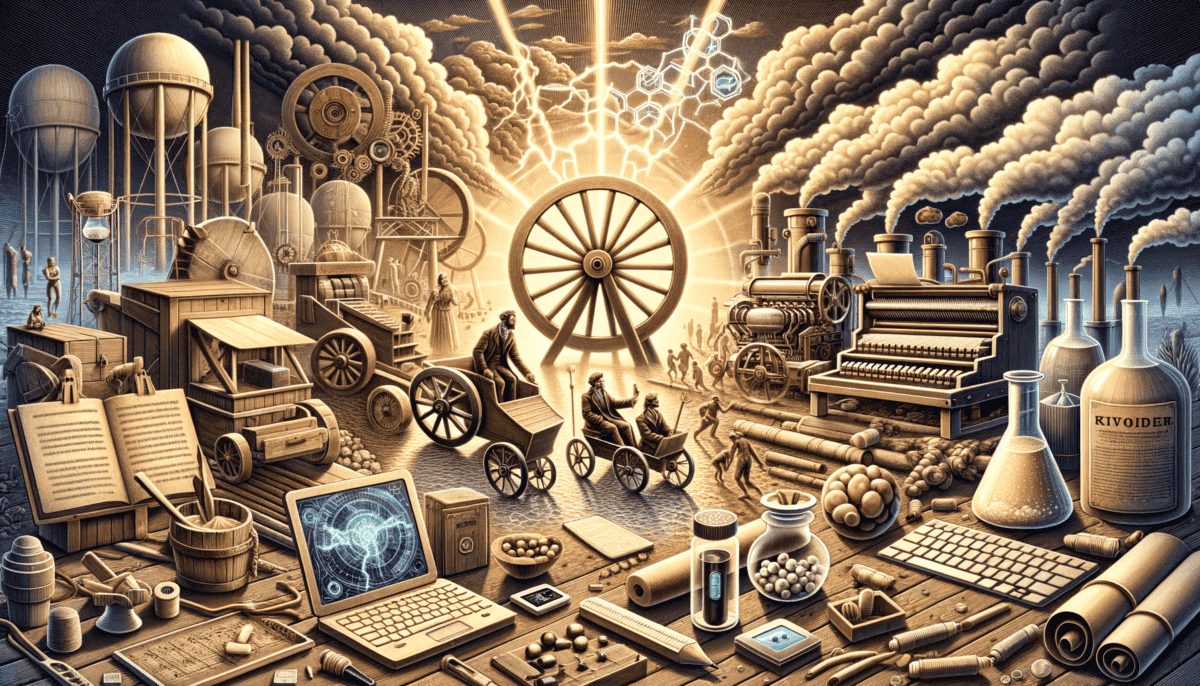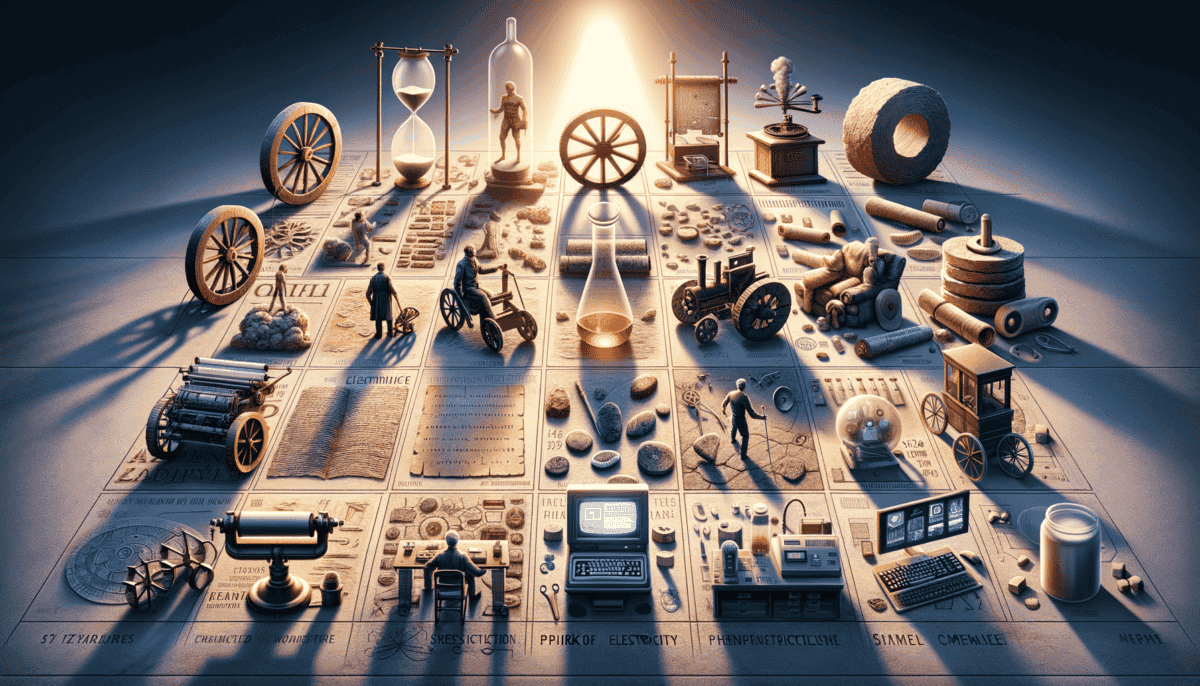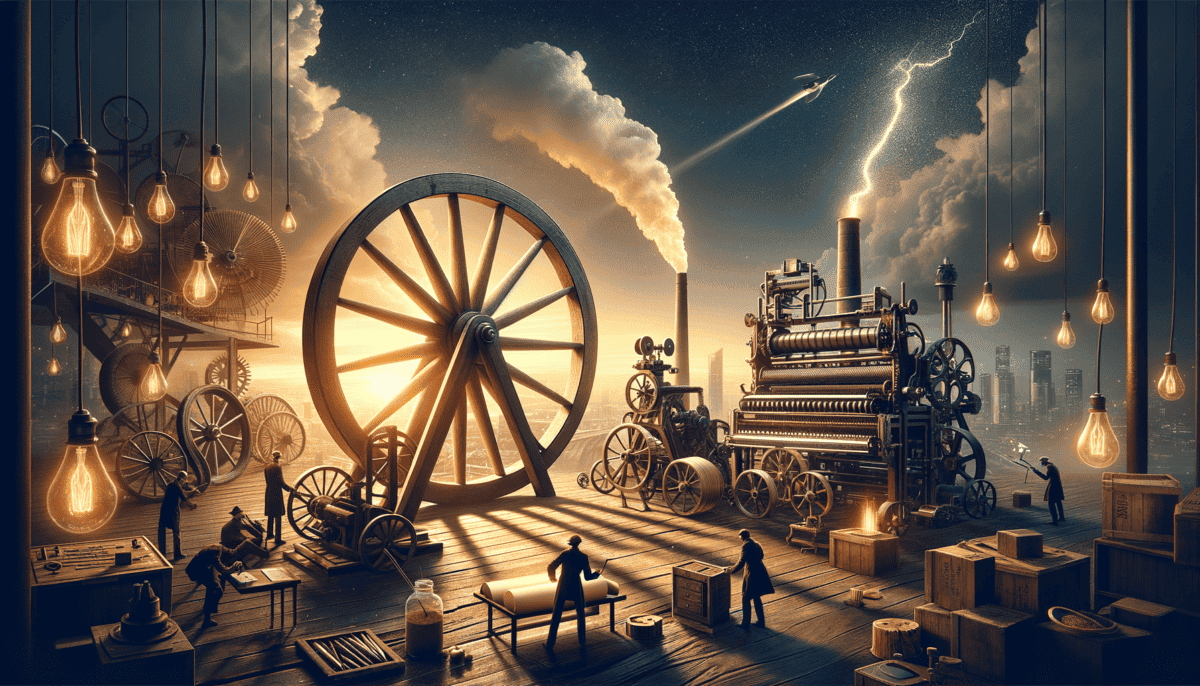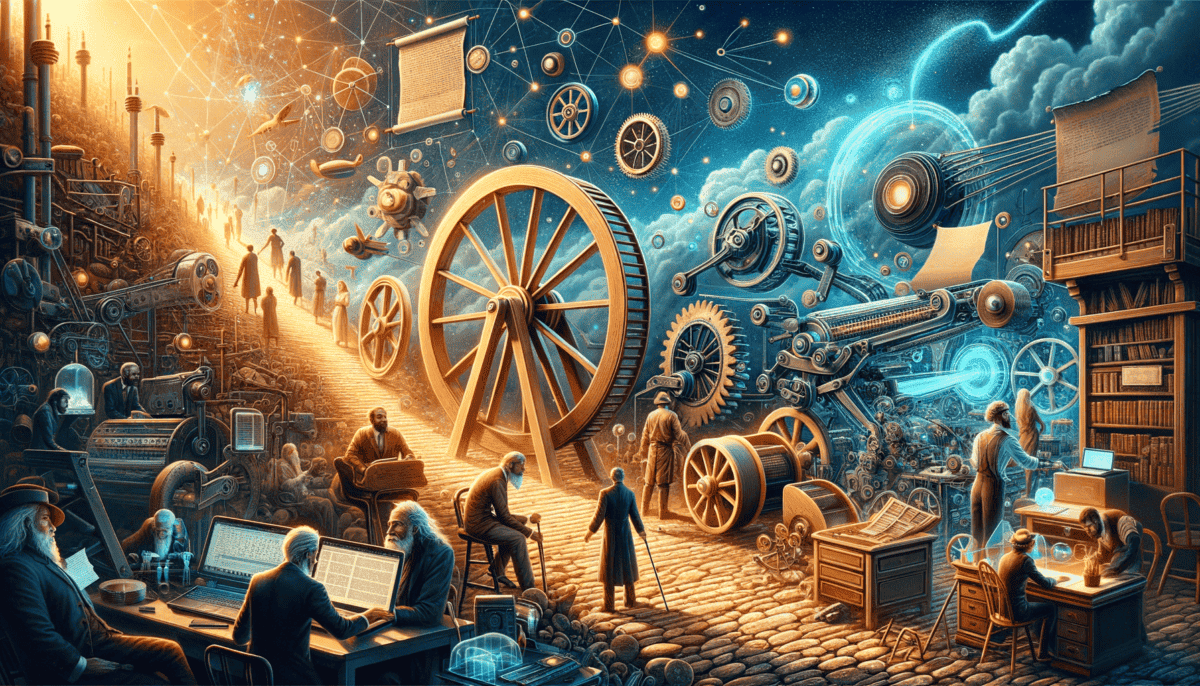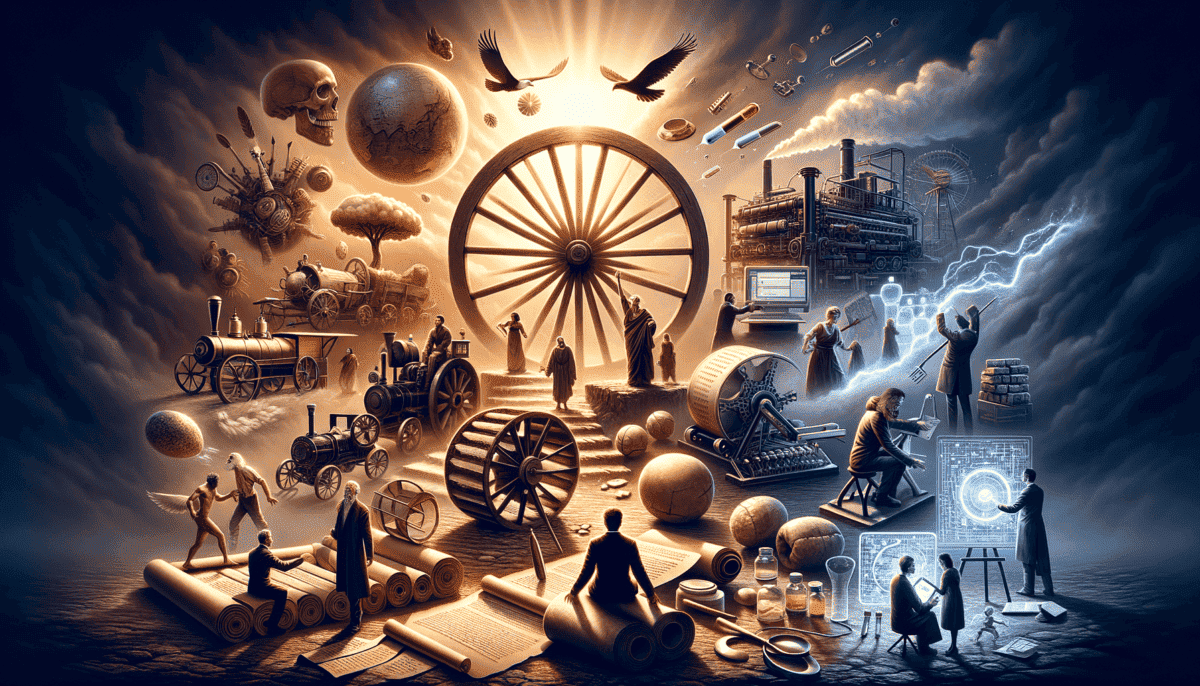A Simple Circle Changes Everything
Long ago, in a place called Mesopotamia, people had a big problem. Moving heavy things was very hard! They had to drag everything on the ground.
Karu was a young boy who loved to watch the grown-ups work. Every day, he saw them struggle to move big stones and clay pots. They would put logs under heavy things and roll them, but the logs would always slip away.
"There must be a better way," Karu thought, scratching his head.
One morning, while playing with a piece of clay, Karu noticed something interesting. When he made the clay round like a ball, it rolled easily! He started to think about the logs his people used.
The Big Idea
"What if we made something round, but flat like a disk?" Karu wondered aloud. He took more clay and shaped it into a circle with a hole in the middle. When he stuck a stick through the hole, it spun perfectly!
Karu ran to show his father. "Look what I made!" he shouted excitedly. His father's eyes grew wide with wonder.
The First Cart
Soon, the whole village was talking about Karu's discovery. The village craftspeople worked together to make bigger versions out of wood. They attached these round wheels to a flat piece of wood, and amazing things happened!
What used to take ten people to move now only needed two! Heavy pots, stones, and food could be transported easily. The wheel made everything better.
“This is magic!” people said. But it wasn’t magic – it was something even better. It was an invention!
Changing the World
News of the wheel spread far and wide. People started making:
• Carts for carrying things
• Chariots for travel
• Water wheels for farming
• Spinning wheels for making clothes
The wheel changed how people lived. Villages could trade with each other more easily. People could travel farther than ever before. Life became much better for everyone!
Karu grew up to be respected throughout his village. He learned an important lesson: sometimes the simplest ideas can make the biggest difference. Just like a wheel, one good idea can keep rolling and rolling, making life better for everyone it touches.
Years later, when Karu's grandchildren asked him about the wheel, he would smile and say, "The best inventions don't have to be complicated. They just need to solve a problem and help people."
At night, Karu would look up at the round moon and think about how one simple shape – the circle – had changed everything. He wondered what other amazing inventions people would create in the future.
Little did Karu know that his invention would inspire people for thousands of years to come. The wheel was just the beginning of humanity's amazing journey of discovery and innovation.
Fire and Lightning – Nature’s Power in Human Hands
Many moons after the wheel was invented, people faced another big challenge. The nights were dark and cold. Wild animals lurked in the shadows.
The First Spark
Maya and her brother Thak huddled in their cave one stormy night. Suddenly, a bright flash lit up the sky! BOOM! ⚡
“Look!” Maya pointed at a tree struck by lightning. It glowed with a warm, bright light. This was their first meeting with fire.
Maya and Thak watched as the other cave people carefully carried the burning branches back to their cave. The fire kept them warm and scared away dangerous animals.
Learning to Make Fire
But they couldn’t always wait for lightning. They needed to make their own fire! After watching sticks get hot from rubbing together, Maya had an idea.
“What if we rub sticks on purpose?” she asked Thak. They tried it, and after lots of tries – it worked! They could make fire whenever they wanted!
“Fire is like having a piece of the sun with us,” Maya said, watching the flames dance.
A Bright New World
Fire made life much better. Now people could:
• Cook food to make it tastier and safer to eat
• Stay warm in cold weather
• Keep dangerous animals away
• Make tools stronger by heating them
• See in the dark
Many, many years later, a man named Benjamin Franklin got very curious about lightning. He wondered if it was like a giant spark of fire in the sky.
Franklin’s Famous Kite
One stormy day, Franklin flew a kite with a metal key tied to it. When lightning struck near the kite, sparks jumped from the key to his hand!
Franklin discovered that lightning was electricity – just like the tiny sparks you sometimes see when you touch a doorknob! This led to one of the most important inventions ever: the lightning rod.
The Power of Electricity
More people started studying electricity. Thomas Edison made the first light bulb that could glow for a long time. Now we didn’t need fire to see in the dark anymore!
Today, electricity powers almost everything we use:
• Lights in our homes
• Computers and phones
• Television sets
• Kitchen appliances
• And so much more!
Just like Maya and Thak’s discovery of fire, learning to use electricity changed how everyone lives. We can cook without fire, stay warm without flames, and light up the night with just a flip of a switch!
As the sun set each evening, Maya would look at the fires burning in her cave. She never imagined that one day, people would have an even more powerful kind of fire – electricity – running through their homes.
The story of fire and electricity shows us something important: when humans learn to use nature’s power, amazing things can happen. What other powers of nature will we learn to use next?
Making Words Last Forever
The sun rose over an ancient city in Mesopotamia. A young girl named Adara watched her father press shapes into wet clay. She wondered why he made these funny marks every day.
The First Stories
“Father, what are those marks?” Adara asked, pointing at the clay tablet.
“These are words, my child,” he smiled. “Now we can remember things forever, not just in our heads.”
Adara watched as her father counted sheep by making marks in the clay. She realized these marks helped him remember how many sheep they had!
From Pictures to Letters
Over many years, the picture-writing got simpler. Instead of drawing a whole sheep, people made quick marks that meant “sheep.” These became the first letters.
“Writing is like catching thoughts and keeping them forever,” Adara told her little brother. ✨
Different places made different kinds of writing:
• Egyptians used pictures called hieroglyphs
• Chinese people painted beautiful characters
• Greeks made an alphabet that helped make our ABCs
The Book Man
Many years later, in Germany, a man named Johannes Gutenberg had a big problem. Books were very rare because people had to write each one by hand!
“There must be a better way,” Gutenberg thought. He watched people use stamps to make marks and got an idea.
Books for Everyone
Before Gutenberg’s printing press, only rich people could have books. Now, more people could read and learn new things. Knowledge spread faster than ever before!
The printing press helped people:
• Learn to read
• Share stories
• Save important information
• Learn about faraway places
• Tell others about their ideas
Words Today
Now we have more ways to share words than ever! We can:
Type on computers
Send messages on phones
✉️ Email friends far away
Read stories from all over the world
Little Adara would be amazed to see how her father’s clay marks grew into all the words we have today. When people learn to write things down, they can share their ideas with the whole world!
From clay tablets to glowing screens, writing helps us remember our stories and share them with others. Just think – the words you’re reading right now started with those first marks in clay thousands of years ago!
Machines That Changed Everything
Steam puffed into the cool morning air as young Thomas watched the huge machines in his father’s factory. The year was 1785, and something amazing was happening in England.
The Power of Steam
“Why does the machine make that whooshing sound, Father?” Thomas asked, his eyes wide with wonder.
“That’s steam power, my boy,” his father explained. “It’s like hundreds of horses working together, but inside this machine!”
Before these machines, people made things by hand in their homes. Now, big factories were popping up everywhere. The world was changing fast!
The Iron Horse
One day, Thomas saw something incredible – a steam train! It moved faster than any horse-drawn carriage he’d ever seen.
“It’s like a dragon made of metal!” Thomas whispered in awe.
George Stephenson, who built the first real railroad, smiled when he heard children call his trains “Iron Horses.” These amazing machines could:
• Carry more things than 100 wagons
• Travel faster than any horse
• Work all day without getting tired
• Connect far-away cities
• Help people travel to new places
Cotton and Steel
In the factories, new machines were making cloth faster than ever before. The spinning jenny could make eight threads at once!
Little Mary, a worker’s daughter, watched the machines spin:
“Look how fast it goes, Mother! It’s like magic!”
“Not magic, dear – it’s invention. People thought of ways to make work easier and faster.”
A World of Changes
The Industrial Revolution brought big changes:
Bright gas lamps lit up dark streets
More people moved to cities for factory jobs
Steam ships carried goods across oceans
⚡ New machines made metal tools and parts
Workers’ Lives
Life changed for workers too. Instead of working at home, they went to big factories. Some changes were hard, but people worked together to make things better.
The New World
As Thomas grew older, he saw his world transform. Trains connected cities, factories made things quickly, and new inventions appeared every year.
The machines of the Industrial Revolution still help us today. When you ride in a car, use something made in a factory, or take a train, you’re seeing the amazing changes that started with steam power and big dreams!
Looking at a modern factory, Thomas would be amazed to see how his world of steam and iron grew into our world of robots and computers. The spirit of invention that started back then is still changing our world today!
The Heroes Who Healed Us
In a small laboratory in 1928, Dr. Alexander Fleming was puzzled. Something strange had happened to his petri dishes. A fuzzy green mold was growing – but wait! Around the mold, there were no germs at all!
A Lucky Accident
“This is remarkable!” Dr. Fleming exclaimed. He had just discovered penicillin, the first antibiotic medicine. It was like finding a magic shield against harmful germs!
The Vaccine Pioneers
Little Sarah watched as Dr. Jonas Salk carefully worked in his laboratory. The year was 1952, and he was trying to stop a scary disease called polio.
“What are you making, Dr. Salk?” Sarah asked.
“I’m making a special medicine called a vaccine,” he smiled. “It will teach your body how to fight off diseases.”
“It’s like giving your body a superhero costume to fight the bad germs!” Sarah giggled.
X-Ray Vision
Marie Curie had a special power – she could see inside people without cutting them open! Well, not exactly. She helped develop X-rays, which let doctors see our bones!
Medical Miracles
These amazing doctors and scientists gave us:
• Medicine to fight germs
• Shots to prevent diseases
• Ways to see inside our bodies
• Better ways to do surgery
• Medicine to stop pain
The Heart Heroes
Dr. Daniel Hale Williams did something amazing in 1893. He fixed a person’s heart!
“But Doctor, how can you fix something that never stops moving?” asked his young assistant.
“Very carefully, and with lots of practice,” Dr. Williams replied with a gentle smile.
Making Medicine for Everyone
Dr. Elizabeth Blackwell became the first woman doctor in America. She opened a hospital where poor people could get help. ⚕️
Modern Medicine Magic
Now we have:
Pills that can fight sickness
Machines that look inside our bodies
New parts to replace broken ones
Ways to fix our genes
Robots that help doctors do surgery
Little Sarah, now grown up with her own children, still remembers watching Dr. Salk in his laboratory. Today’s doctors are still making amazing discoveries, finding new ways to keep us healthy and make sick people better.
Every time someone gets better from being sick, they can thank these brave doctors and scientists who worked so hard to help others. Their discoveries are still helping people today, and new medical heroes are making more discoveries every day!
Digital Dreams Come True
Little Tommy sat in front of a giant computer that filled an entire room. The year was 1965, and he watched in wonder as his father typed on a keyboard. “Dad, will computers always be this big?” he asked. ️
The First Computers
“One day, Tommy, computers will be small enough to fit in your pocket!” his father smiled.
“No way!” Tommy laughed. “That’s impossible!”
Steve and Steve’s Big Idea
In 1976, two friends named Steve (Jobs and Wozniak) had a dream. They wanted to make computers that everyone could use at home. They started Apple Computer in a garage!
“We can change the world with this,” Steve Jobs said to his friend.
“But will people want computers in their homes?” Wozniak wondered.
The Internet: Connecting Everyone
In 1989, Tim Berners-Lee had an amazing idea. What if we could connect all computers together? He created the World Wide Web!
Digital Tools We Use Today
• Smartphones that fit in our pockets
• Tablets for reading and playing
• Video games that look real
• Robots that help us work
• Computers that help us learn
Tommy’s Dream Comes True
Today, Tommy is a grandpa. He shows his grandson a smartphone. “See? I told you computers would fit in your pocket one day!”
His grandson giggles, “But Grandpa, what will we have next?”
“That’s the most exciting part,” Tommy says. “We don’t know yet! Maybe computers will be as tiny as dust, or maybe we’ll have robots that are our friends!”
The Future is Bright
From the first wheel to modern computers, people have always dreamed big. Every invention started with someone asking, “What if?”
Looking back at all these amazing inventions – the wheel, fire, writing, machines, medicine, and computers – we can see how far we’ve come. But the most exciting part is thinking about what’s next!
Maybe you’ll be the one to invent something that changes the world. After all, every great invention started with someone like you, asking questions and dreaming big dreams.
The story of invention never ends. It just keeps rolling forward, like that very first wheel, taking us to new and exciting places we haven’t even imagined yet. What will YOU invent?


